- DroidAfrica
- Gadgets
- BLU
- BLU G91 Max
BLU G91 Max

BLU G91 Max Highlights and Overview
The Blu G91 Max is the higher variant of all G91-series. The model has better CPU and come with 8GB RAM instead of the 4 or 6GB RAM in the other models. From the font, the device sports a 6.8-inches FHD+ display with 1080 x 2460 pixels. The screen panel is IPS, and it has a centralized punch notch in the middle.

Powering the G91 Max is MediaTek’s Helio G95 gaming CPU. The Chipset has 8-core CPUs maxed at 2.05GHz, along with Mali-G76 MC4 GPU. Storage options is a single 8GB RAM with 128-Gigs of internal ROM, expandable via micro SD-card up to 256GB.
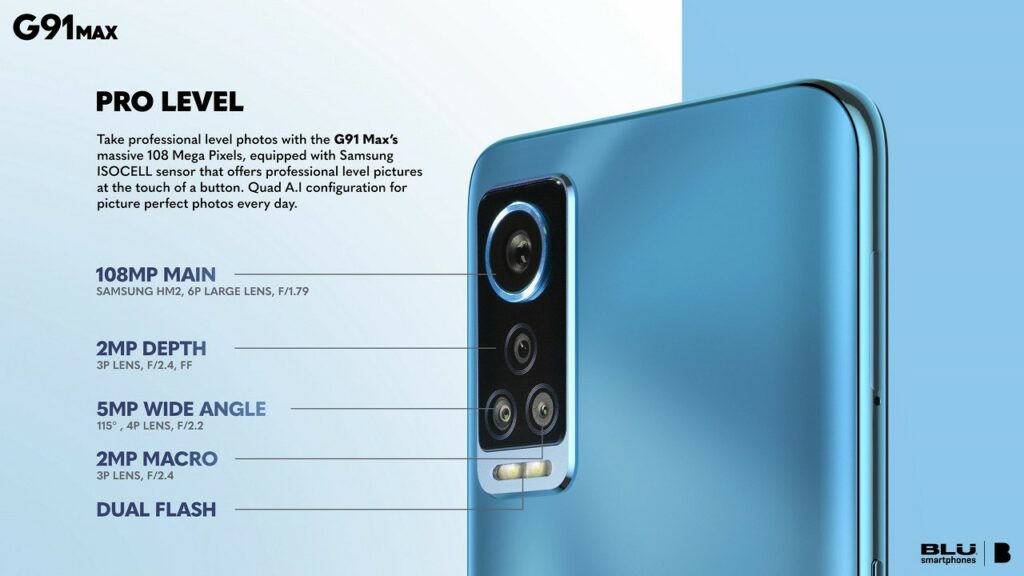
As for the camera department, you are getting four lenses on the rear; a 108-megapixel Samsung HM2 lens, a 5-megapixel Ultrawide angle lens, 2-megapixel depth and a fourth 2-megapixel macro lens, while a single 16-megapixel selfie snapper is kept upfront.
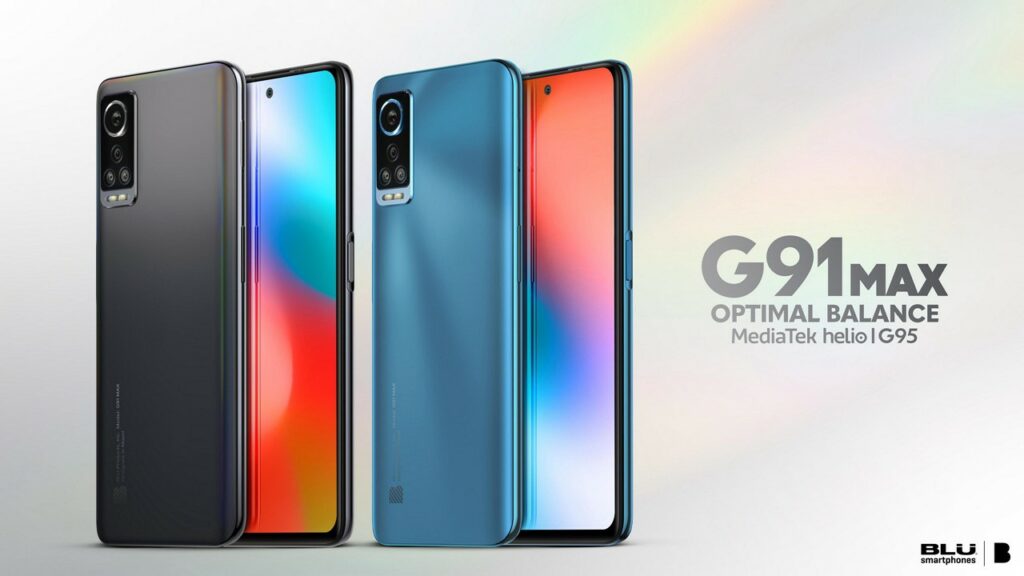
There is a built-in 5000mAh battery that support 18W wired and 10W wireless charging. You are also getting a side-mounted fingerprint scanner, as well as a slot for dual 4G enabled SIMs. Color option includes Spectrum Gray and Sky Blue, while Google Android 11 is available out of the box. The full specifications of BLU G91 Max is contained in the table below.
BLU G91 Max Full Specifications and Features
NETWORK
| Technology | GSM / HSPA / LTE |
| 2G Network Bands | GSM 850 / 900 / 1800 / 1900 - SIM 1 and SIM 2 |
| 3G Network Bands | HSDPA Bands 850 / 900 / 1700 / 1900 / 2100 |
| 4G Network Bands | LTE band 2 / 3 / 4 / 5 / 7 / 12 / 13 / 17 / 28 / 38 |
| Speed | HSPA 42.2/5.76 Mbps, LTE-A |
LAUNCH
| Also Known As |
- - |
BODY
| Dimensions | 168.6 x 77 x 8.9 mm |
| Weight | 213 grams |
| Build | Glass front / Plastic back / Plastic frame |
| SIM Type | Dual SIM (Nano-SIM, dual stand-by) |
DISPLAY
| Display Type | IPS LCD capacitive touchscreen, 16M colors |
| Size | 6.8 inches, (84.7% screen-to-body ratio) |
| Resolution | 1080 x 2460 pixels, 20.5:9 ratio (~396 ppi density) |
PLATFORM
| Operating System | Android 11 |
| Chipset | Mediatek MT6785 Helio G95 (12 nm) |
| CPU | Octa-core (2x2.05 GHz Cortex-A76 & 6x2.0 GHz Cortex-A55) |
| GPU | Mali-G76 MC4 |
MEMORY
| RAM + ROM | 8GB + 128GB |
| Card Slot | Yes, up to 256GB via microSD card |
MAIN CAMERA
| Camera Type | Quadruple Lenses |
| Camera Sensor(s) |
Main: 108 MP, f/1.8, PDAF Ultrawide: 5 MP, f/2.2, 115˚ Macro: 2 MP, F/2.4 Depth: 2 MP, F/2.4 |
| Camera Features | Autofocus, Continuous shooting, Digital zoom, HDR, Touch focus, Face detection, LED flash |
| Video Resolution | 1080p@30fps |
SELFIE CAMERA
| Camera Type | Single Lens |
| Camera Sensor(s) | 16-megapixel |
| Video Resolution | 1080p@30fps |
SOUND
| Loudspeaker | Yes |
| Speaker Location | Chin, below display |
| Audio Jack Type | Yes, 3.5mm audio jack, |
CONNECTIVITY
| Bluetooth | Bluetooth 5.1, A2DP, LE |
| NFC | |
| GPS | Yes, with dual-band A-GPS, GLONASS, BDS, GALILEO, QZSS |
| FM Radio | No |
BATTERY
| Battery Capacity | Non-removable Li-Po 5000mAh battery |
| Wireless Charging | Yes, 10W wireless charging |
OTHER FEATURES
| Sensors | Fingerprint (side-mounted), accelerometer, proximity, compass |
| Box Contents | Charging Brick / USB cable |
BLU G91 Max User Reviews and Opinions
LEAVE A REPLY
Disclaimer Note
We CANNOT guarantee 100% accuracy for the specification table above.


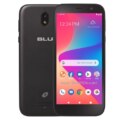
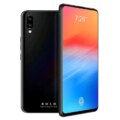
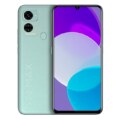
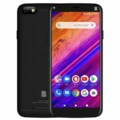







I really like the overall specs and features of this mediatek powered smartphone, the battery and RAM combo is insane!